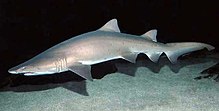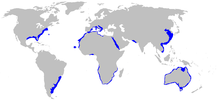
Back Skeurtandhaai Afrikaans قرش الرمل الببري Arabic قرش الرمل الببرى ARZ Обикновена сива акула Bulgarian Solraig clapejat Catalan Carcharias taurus CEB Žralok písečný Czech Sandtigerhai German Καρχαρίας ταύρος Greek Carcharias taurus Spanish
| Sand tiger shark | |
|---|---|

| |
| Scientific classification | |
| Domain: | Eukaryota |
| Kingdom: | Animalia |
| Phylum: | Chordata |
| Class: | Chondrichthyes |
| Subclass: | Elasmobranchii |
| Subdivision: | Selachimorpha |
| Order: | Lamniformes |
| Family: | Odontaspididae |
| Genus: | Carcharias |
| Species: | C. taurus
|
| Binomial name | |
| Carcharias taurus Rafinesque, 1810
| |

| |
| Range of the sand tiger shark | |
| Synonyms | |
|
Carcharias tricuspidatus Day, 1878 | |
The sand tiger shark (Carcharias taurus), gray nurse shark, spotted ragged-tooth shark or blue-nurse sand tiger, is a species of shark that inhabits subtropical and temperate waters worldwide. It inhabits the continental shelf, from sandy shorelines (hence the name sand tiger shark) and submerged reefs to a depth of around 191 m (627 ft).[2] They dwell in the waters of Japan, Australia, South Africa, and the east coasts of North and South America. The sand tiger shark also inhabited the Mediterranean, however it was last seen there in 2003 and is presumed extinct in the region. Despite its common names, it is not closely related to either the tiger shark (Galeocerdo cuvier) or the nurse shark (Ginglymostoma cirratum).
Despite its fearsome appearance and strong swimming ability, it is a relatively placid and slow-moving shark with no confirmed human fatalities. This species has a sharp, pointy head, and a bulky body. The sand tiger's length can reach 3.2 m (10.5 ft) but is normally 2.2–2.5 m in length.[3] They are grey with reddish-brown spots on their backs. Shivers (groups) have been observed to hunt large schools of fish. Their diet consists of bony fish, crustaceans, squid, skates and other sharks. Unlike other sharks, the sand tiger can gulp air from the surface, allowing it to be suspended in the water column with minimal effort. During pregnancy, the most developed embryo will feed on its siblings, a reproductive strategy known as intrauterine cannibalism i.e. "embryophagy" or, more colorfully, adelphophagy—literally "eating one's brother". The sand tiger is categorized as critically endangered on the International Union for Conservation of Nature Red List. It is the most widely kept large shark in public aquariums owing to its tolerance for captivity.
- ^ Cite error: The named reference
IUCNwas invoked but never defined (see the help page). - ^ Cite error: The named reference
Compagno1was invoked but never defined (see the help page). - ^ "Carcharias taurus: Sandtiger Shark". Florida Museum of Natural History. 18 October 2018. Retrieved 6 May 2019.
© MMXXIII Rich X Search. We shall prevail. All rights reserved. Rich X Search
